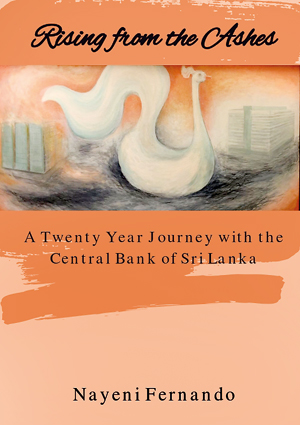A banking saga with a personal touch
View(s): Nayeni Fernando’s book is a fascinating documentation of two significant events in the country’s banking. It is an interesting personal narrative of the introduction of automated cheque clearing in Sri Lanka and the tragic bombing of the Central Bank building on January 31, 1996 and its restoration.
Nayeni Fernando’s book is a fascinating documentation of two significant events in the country’s banking. It is an interesting personal narrative of the introduction of automated cheque clearing in Sri Lanka and the tragic bombing of the Central Bank building on January 31, 1996 and its restoration.
Nayeni documents in detail the process of establishing the automated cheque clearing facility at the Central Bank that had far-reaching benefits for banking in Sri Lanka. The efficacy and speed of cheque clearing achieved by the computerized facility was a revolution in banking. She gives a detailed account of this achievement of the Central Bank, the persons involved, the difficulties encountered and the progress achieved.
More absorbing is her personal story of the tragic bombing of the Central Bank building, the loss of 41 lives, serious injury to many others and the collapse of the building. This horrendous tragic event was a “devastating experience” to the author. She lost many of her friends with whom she had worked for many years. It was a traumatic experience as she lost her closest friend, Sriyani Hamid (nee Pieris), a friend from her schooldays at Methodist College. It is a moving story of that dark day. It recounts the fears, anxieties and trauma of many Central Bankers and their families.
The book also includes Nayeni’s daughter, Hasitha’s description of the emotional anxiety she and the family went through on that dark day. In her brief account Hasitha pleads that communal animosities should not be evoked ever again and wishes that her children would never ever see the tragedy of communal violence.
In spite of this enormous destruction and human tragedy, the Central Bank recommenced business with very little interruption. Nayeni gives an account of how the Bank went about performing its core functions with little disruption owing to the fortitude and commitment of the grieving staff. Nayeni’s account of the tireless and dedicated work of Central Bankers is worthy of being recorded.
The Central Bank rebuilt the old building and built an impressive state of the art new wing. Much of the credit for this resilience and rebuilding of the Central Bank must go to the Governor of the Central Bank, the late Deshamanya A.S. Jayawardena, who acted with equanimity, courage, fortitude and foresight. The book has been deservedly dedicated to Governor Jayawardena.
This resurgence of the Central Bank has been aptly described as “Rising from the Ashes”, the title of the book. The inspiration of the Greek mythological story motivated Governor Jayawardena. He in turn instilled it in the Central Bankers who helped restore the Bank to a new beginning.
Nayeni Fernando’s book is is an important contribution towards understanding the country’s banking history and a slice of the country’s social and political history as well.
The tragic human story must have been difficult to write, as it was difficult for me to read, as Nayeni and I shared the sad loss of many of our friends with whom we had worked for many years.
| Book facts | |
| Rising from the Ashes — A Twenty Year Journey with the Central Bank of Sri Lanka – by Nayeni Fernando. Ravaya Publishers, Colombo. Reviewed by Nimal Sanderatne |


